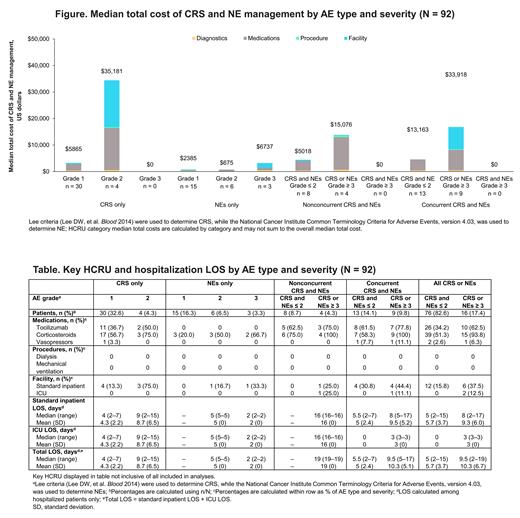Background:CAR T cell therapies are associated with cytokine release syndrome (CRS) and neurological events (NEs). Lisocabtagene maraleucel (liso-cel) is an autologous, CD19-directed, 4-1BB CAR T cell product administered at equal target doses of CD8 + and CD4 + CAR + T cells. There is limited published research on AE management-related health care resource utilization (HCRU) and costs in the second-line (2L) setting. The objective of this study was toestimate HCRU and costs for managing CRS and/or NEs after liso-cel administration among patients with R/R large B-cell lymphoma (LBCL) treated with liso-cel as 2L therapy in the TRANSFORM (NCT03575351) and PILOT (NCT03483103) studies.
Methods: A microcosting methodology was used to assess CRS and/or NE management-related HCRU identified from pooled TRANSFORM and PILOT case report forms and to estimate associated costs among patients who experienced CRS or NEs after liso-cel administration. CRS or NEs were only included if the AE initiated within 90 days after the patient received liso-cel. HCRU categories captured the following: facility (eg, standard inpatient hospitalizations and ICU admissions and length of stay [LOS]), procedures (eg, dialysis and mechanical ventilation), diagnostics (eg, laboratory, imaging, and biopsy), and medications (eg, oncology supportive care, prophylactics, and other AE management). In the nonconcurrent and concurrent CRS/NE categories, events were classified per the highest grade event. HCRU by grade, per the study's management guidelines, were identified from onset of the AE through resolution. Lee criteria were used to determine CRS event grades (Lee DW, et al. Blood 2014), while the National Cancer Institute Common Terminology Criteria for Adverse Events, version 4.03, was used to determine NE grades. Unit costs from publicly available data sources (United States [US] Centers for Medicare & Medicaid Services, Healthcare Cost and Utilization Project, and IBM ® Micromedex ® RED BOOK ®) or published literature were applied to each HCRU after being adjusted to 2021 US dollars using the Consumer Price Index as needed. Analyses were stratified by grade and concurrency.
Results: Among 150 patients treated with liso-cel, 92 (61%) experienced CRS and/or NEs, which were mostly grade ≤ 2 events (n = 76 [83%]). Most patients experienced CRS only (n = 34 [37%]) or NE only (n = 24 [26%]) that ranged in total median cost of $675 for grade 2 NE only to $35,181 for grade 2 CRS only (Figure). In the remaining patients, most experienced AEs concurrently (22/34 [65%]) vs nonconcurrent (12/34 [35%]) with total median costs ranging from $5018 for nonconcurrent grade ≤ 2 CRS/NE to $33,918 for concurrent grade ≥ 3 CRS/NE. Median total cost for grade ≥ 3 CRS/NE was equal to $24,219 versus $5312 for grade ≤ 2, reflecting an additional $18,907 or 356% increase in cost of grade ≥ 3 compared with grade ≤ 2. Facility and medications were the major contributors to CRS/NE management costs. Only 20% (18/92) of patients were hospitalized and 2% (2/92) of patients admitted to the ICU, with proportions higher among grade ≥ 3 CRS/NE than grade ≤ 2 (standard inpatient hospitalization: 6/16 [38%] vs 12/76 [16%]; ICU: 2/16 [13%] vs 0/76 [0%]; Table). Patients with grade ≥ 3 CRS/NE had a median total 4.5 days longer LOS than grade ≤ 2 (median [range], 9.5 [2-19] vs 5 [2-15], respectively). Some medication usage was also higher among patients with grade ≥ 3 CRS/NE compared with grade ≤ 2 (tocilizumab: 10/16 [63%] vs 26/76 [34%]; corticosteroids: 15/16 [94%] vs 39/76 [51%]; vasopressors: 1/16 [6%] vs 2/76 [3%]). No dialysis or mechanical ventilation was recorded for patients experiencing CRS/NE.
Conclusions: Over half of patients with R/R LBCL experienced any-grade CRS and/or NEs after liso-cel administration in TRANSFORM and PILOT, and the majority of these (83%) were low grade. Resource use and costs for management of AEs among patients with less severe CRS/NEs were relatively minimal compared with patients who had more severe CRS/NEs (with the exception of a few outliers). In general, HCRU and costs increased with greater severity. These results are largely consistent to those for third-line-treated patients (Abramson JS, et al. Blood Adv 2021). Additionally, results presented here further support that CAR T cell therapies with low rates of CRS/NEs (and few events are of higher severity) have the potential to minimize AE management-related HCRU and costs among patients with LBCL.
Disclosures
McGarvey:Bristol Myers Squibb: Research Funding. Gitlin:Bristol Myers Squibb: Research Funding. Lee:Bristol Myers Squibb: Research Funding. Keating:Bristol Myers Squibb: Divested equity in a private or publicly-traded company in the past 24 months, Ended employment in the past 24 months. Barghout:Bristol Myers Squibb: Consultancy; Taiho: Consultancy; Novartis: Consultancy; Regeneron: Consultancy; Sun Pharma: Consultancy. Tiwana:Bristol Myers Squibb: Current Employment, Current equity holder in publicly-traded company.


This feature is available to Subscribers Only
Sign In or Create an Account Close Modal